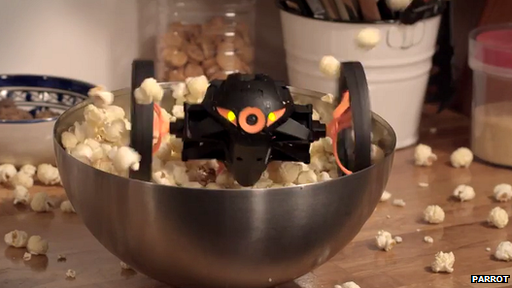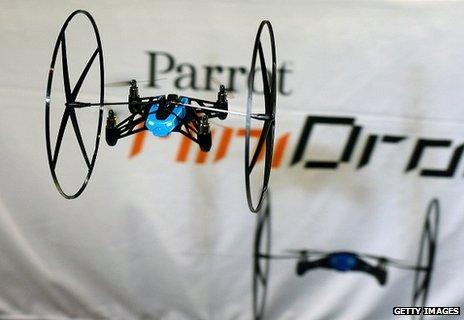CES 2014: Parrot's latest app-driven toys jump and fly
- Published

A promotional video shows the Jumping Sumo leaping between kitchen objects
A two-wheeled "robot insect" that can launch itself into the air, and a "miniature" flying drone are the latest hi-tech toys to be unveiled by Parrot.
The French firm is showing off its latest products at the Consumer Electronics Show in Las Vegas.
Both can be controlled using a smartphone or tablet.
The firm already makes one of the best-selling consumer drones. But one gadget expert questioned the safety of one of its latest machines.
"The Jumping Sumo sounds fun, but it really gives itself a vigorous push to make itself jump," said Stuart Miles, founder of tech news site Pocket-lint.
"You can easily see someone getting smacked in the face or more likely it wiping out the contents of a coffee table or knocking over a vase - wives and mothers will go mental."
The price and release date for both toys have yet to be announced.
Budget drone
The Jumping Sumo runs around on two wheels and can make sharp 90-degree turns because each wheel is independently controlled. But its key selling point will be its ability to jump 80cm (31.5in) into the air, allowing it to leap over gaps or on to objects above it.
A promotional video, external shows the machine jumping between two kitchen surfaces and then on to shelves, scattering objects in its path.
It is controlled via wi-fi, features a camera that can stream video to the connected smart device and, according to a demo seen by Stuff Magazine, external, can last about 20 minutes between charges.

The MiniDrone can be fitted to two wheels that allow it to roll along surfaces
MiniDrone is a fraction of the size of the firm's best-known flying contraption, the AR Drone 2. But like its larger sibling, it has four plastic rotors to get airborne and then uses a gyroscope, speed and height sensors to hover in one spot, fly around or flip over in the air.
Three consequences of the machine's reduced size are that its battery can only keep it flying for up to eight minutes at a time; it connects to a smart device using Bluetooth 4.0 Low Energy rather than wi-fi, which reduces its range; and it cannot stream video from its camera.
It does, however, gain one ability: it can be clipped into a two-wheeled structure that allows it to roll around floors, ceilings and walls.
Another expected benefit is that it should be cheaper than the larger model, which costs about £300.

Rotor Concept is showing off drones capable of operating a DSLR camera
"If they can get it low enough that it's less than the remote-controlled helicopters that you see in all the gadget shops then it could do really well because it will be classed as a fun toy rather than a luxury that you'd never buy," said Mr Miles.
Other exhibitors at CES with flying-themed electronics include:
PowerUp Toys, which is a showing a piece of kit featuring a small rotor and Bluetooth radio that attaches to a paper plane allowing a smartphone to control its speed and direction
Rotor Concept, which is showing off quadcopters that can support GoPro cams or larger DSLR cameras
DJI, a Chinese firm that recently launched Phantom 2 Vision, a quadcopter that allows its owner to take 14MP photos and 1080p high definition video from a distance of 300m (1,000ft)
- Published6 January 2014
- Published3 January 2014
- Published4 December 2013